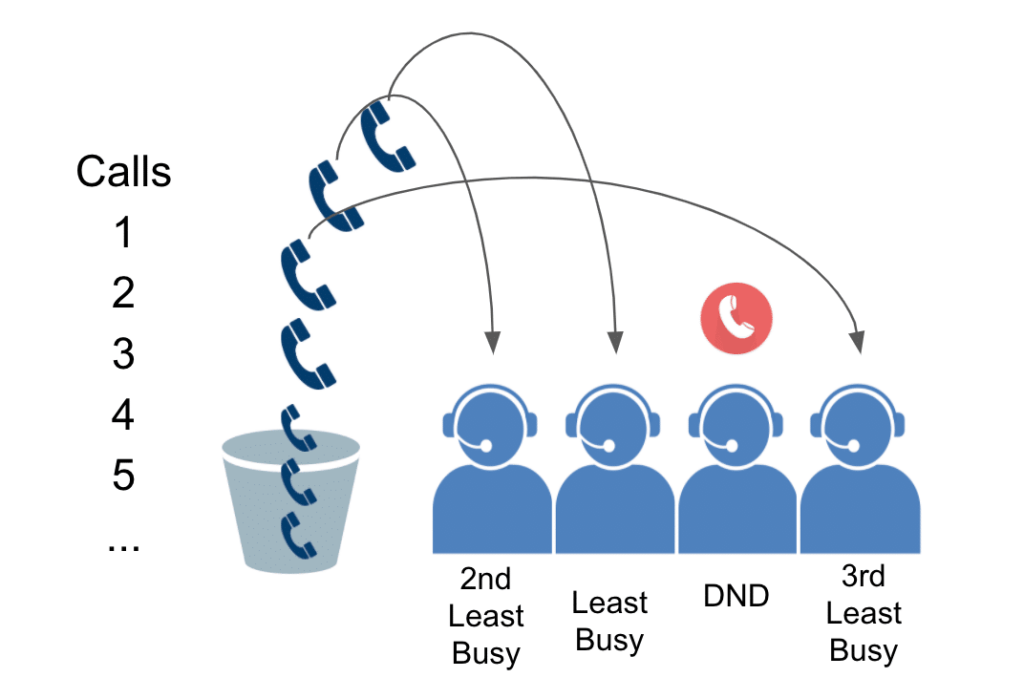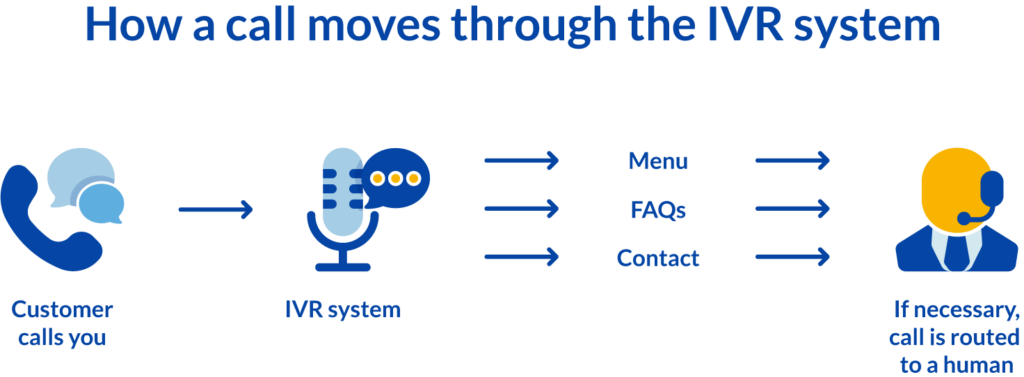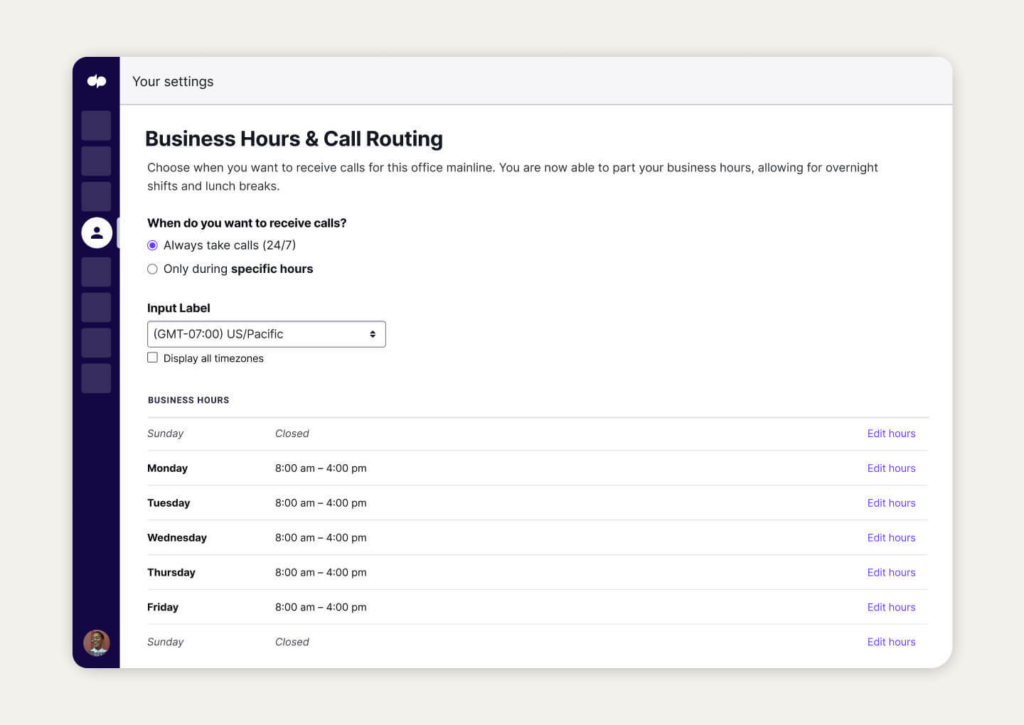Call queuing is an essential component of call center management that enables efficient routing of incoming calls.
When call volume exceeds the number of agents available, call queuing puts customers on hold and lines them up to wait for the next available agent.
Though customers may spend more time waiting, queuing prevents lost calls and improves the customer experience.
Effective call queue management ensures calls are answered on time, boosts productivity through balanced workloads, and provides valuable analytics for improving operations.
Read on to learn more about how call queuing works, why queue management matters, common problems like long wait times, and optimization tips.

What Is a Call Queue?
A call queue is a system that puts incoming calls on hold when all agents are busy with active calls.
Instead of getting a busy signal or being disconnected, callers are placed into a waiting line queue. The queued calls are then routed to agents in the order they were received once agents become available.
Call queues enable call centers to handle spikes in incoming call volume without losing any callers.
Even during times when agents are occupied, new calls can be held until the next agent is free to take the next queued customer.

How Do Call Queues Work?
Call queues are used to manage incoming calls and route them to available agents.
- When a call comes into a call center, it enters the call queue. This is a waiting line for calls.
- The calls are placed in line based on time of arrival and/or priority level.
- Music, messages, or ads may play while callers wait for the next available agent.
- Queue statistics like average wait time, number of callers, etc. are tracked in call center software.
- Agents are assigned to queues and take the next call when they are available.
Call routing sends callers to the appropriate queue.
- Dialed number and Interactive Voice Response menus determine the queue for each caller.
- Skills-based routing uses agent skills and experience to match callers with the right agent.
- Geographical routing sends callers to agents in a certain location.
- Overflow routing moves callers to secondary queues if the primary queue is full.
- Real-time traffic reports adjust routing plans to reduce wait times.
Queue priority determines the order in which calls are answered.
- Higher-priority callers move ahead in line over lower-priority ones.
- Priority can be based on caller ID, account status, or call type.
- VIP customers may get first access to agents by being placed at the front of the queue.
- Emergency calls like 911 are instantly routed to the next available agent.
- Rules are set to escalate calls that have waited too long to a higher priority.
Agents manage multiple queues for better efficiency.
- Agents can be assigned to multiple queues and take calls from all of them.
- Skill-based routing allows each agent to handle calls that match their expertise.
- Idle agents are distributed across queues based on real-time workload.
- Agents may temporarily stop taking calls from one queue if another has higher demand.
- Queues are centralized across locations for round-the-clock coverage.
Call center software provides visibility and analytics.
- Real-time dashboard shows queue statistics like wait time, abandonment rate, etc.
- Historic reports identify trends to adjust staffing levels and call routing.
- Agents’ productivity metrics are tracked to improve individual and team performance.
- Alerts notify managers if service level targets are not being met.
- Data guides supervisors in managing queues and agents more effectively
Main Components of a Call Queue System
Several key components make up a call queue system:
1. PBX
The PBX (Private Branch Exchange) telephone system receives and routes all incoming calls. When no agents are available, the PBX places the call into a waiting queue.

2. ACD
The Automatic Call Distributor (ACD) is part of the PBX system that distributes waiting calls to agents as they become available.
The ACD follows the queue rules set by the call center.
3. IVR
The Interactive Voice Response (IVR) system greets the caller with a recorded message when they enter the queue.
The IVR provides queue information, like estimated wait times and queue position.

4. Hold Music/Messages
To improve the on-hold experience, call centers use music, promotional messages, or important information while customers are in the queue.
5. Call Center Agents
Agents are the employees who answer queued customer calls. The ACD distributes calls to agents according to the routing rules.
Key Benefits of Using Call Queues
Several major benefits call queues provide for call centers:
- Ensures calls are answered and served in the order they are received.
- Allows call centers to handle surges in incoming calls without losing callers.
- Provides important announcements and messages to callers while they wait.
- Gives callers confidence that their call will be answered since they have a place in line.
- Reduces abandoned calls because callers don’t get busy signals and disconnect when queues are used.
By implementing call queuing, call centers create smooth call handling even when call volumes exceed staff capacity. This promotes excellent customer service.
What is Call Queue Management?
Call queue management refers to the systemized and methodical routing of incoming calls to available customer service agents or representatives in a call center environment.
It involves intelligently organizing and sequencing incoming customer calls in a holding pattern or queue until a suitable agent is free to take the next call.
Effective call queue management is critical for ensuring incoming calls are answered and routed to the right agents promptly and efficiently.

It enables call centers to deliver a smooth, frustration-free experience to calling customers while optimizing agent productivity and call center resources.
At its core, call queue management aims to connect each incoming customer call to an available, knowledgeable agent as quickly as possible.
Sophisticated call queue systems use algorithms and real-time data to determine the most optimal way to distribute waiting calls to agents.
Why is Call Queue Management Important?
Smooth and intelligent call queue management provides several important benefits:
- Reduces Wait Times – By sequencing and prioritizing incoming calls dynamically based on configurable parameters like priority status, wait time, etc., customers spend less time waiting in the queue leading to greater satisfaction.
- Increases Agent Productivity – With an organized call workflow, agents spend less time idle and can handle more calls per hour. Visibility into queue data also helps optimize staffing.
- Enhances Customer Experience – Shorter wait times, prompt call routing and fewer dropped calls enhance the overall customer experience and satisfaction significantly.
- Provides Actionable Insights – Reporting on key call queue KPIs like average speed to answer, abandonment rates, etc. allows gaps to be identified and operations improved.
- Drives Efficiency – Historical call volume analysis enables better demand forecasting and staffing alignment resulting in shorter queues even during peak times.
- Scales Operations – Smart algorithms maintain queue discipline and quality of service even amidst fluctuations in call volumes and staffing.
Key Features of Effective Call Queue Management
- Automatic Call Distribution – Automatically distributes incoming calls to the best-suited available agent according to pre-configured parameters.
- Skills-based Routing – Routes calls requiring specific expertise to agents with the required skillsets and language abilities.
- Priority Queuing – Allows prioritizing high-value customers in the queues over regular customers for quicker response.
- Customizable Queue Treatment – Options to play music, announcements, provide call-back options, etc.. to enhance the experience of waiting callers.
- Real-time Reporting – Provides supervisors with real-time visibility into queue performance, agent activities, and service levels.
- Historical Analytics – Insights based on past call volumes, wait times and service levels help inform staffing and training decisions.
- Overflow Routing – Route calls to alternate destinations or queues during peak periods and high wait times to prevent abandonment.
- Queued Callbacks – Callers waiting beyond a threshold can opt for callbacks when agents are available rather than waiting in queue.
Overall, intelligent call queue management is indispensable for call centers to deliver exceptional customer service.
By systematically directing waiting calls to available best-fit agents, call queues reduce frustrations, optimize operations, and enable scaling to meet changing demands.
The right queue management solutions provide process automation, actionable insights, and the flexibility to adapt, making call centers more effective and customer experiences better.
What Causes Long Call Queues?
While call queues are useful, excessively long queues lead to negative experiences. Several potential factors can create lengthy call queues.
1. Sudden Call Volume Spikes
Significant short-term surges in inbound call volumes quickly extend queue lengths:
- Mondays may see increased call volume after weekends.
- Holidays often drive higher order volumes and customer service calls.
- New product releases generate interest and questions.
- Current news events or disasters require customer outreach.
If spikes exceed forecasts, more calls flood in than agents can handle. Queues instantly grow.
2. Staffing Issues
Problems with staffing numbers, scheduling, and absences increase queue wait times:
- Insufficient headcount leads to more calls than agents available.
- Inaccurate forecasting and scheduling create understaffing when calls spike.
- Unplanned absences like sickness deplete scheduled staffing.
3. Inefficient Business Processes
Lengthy internal workflows reduce agent productivity and capacity:
- Slow support tools like CRMs increase handle times.
- Complex service processes prolong calls.
- Repeat callers add to the overall call volume.
4. Suboptimal Routing Configurations
Poor queue configurations and routing creates congestion:
- Low queue limits cut callers off too soon.
- Failing to prioritize valued customers.
- Not overflowing calls to other queues or sites.
How To Improve Call Queue Management?
Here are the top ways call centers can optimize queue management for better customer experiences:
1. Adjust Queue Parameters
- Set maximum queue length thresholds based on service level targets. For example, limit the queue to 10 callers maximum.
- Define maximum expected wait times, such as capping at 10 minutes.
- Continuously monitor thresholds and adjust as needed based on service level attainment.
- Implement priority queuing for certain caller segments like premium customers.
2. Refine Call Routing
- Leverage skills-based routing to get callers to the right agents based on skillset and experience.
- Build in dynamic overflow to other queues or sites during periods of congestion.
- Optimize routing logic regularly as agent skills, and queues change.

3. Monitor in Real-Time
- Actively watch queue dashboard metrics for wait times, lengths, and abandons.
- Make real-time adjustments to agent staffing when thresholds are breached.
- Empower team leads to quickly assign more agents if queues spike suddenly.
- Ensure constant monitoring for timely reactions and issue resolution.
4. Review Historical Trends
- Analyze weekly and monthly queue data to identify recurring patterns and root causes.
- Review year-over-year trends to improve forecasting and staff planning.
- Drill down into periods of poor performance to diagnose and correct issues.
- Share insights across the operations team to inform future queue management.
5. Listen to Customer Feedback
- Survey callers following interactions to gauge queue experience satisfaction.
- Monitor social channels for complaints about hold times or drops.
- Solicit customer input directly through focus groups or feedback forms.
- Incorporate findings into regular reviews of queue operations and policies.
6. Optimize Business Processes
- Identify and improve processes that influence queue operations like handle times.
- Keep knowledge bases, and tech tools updated to avoid handling delays.
- Eliminate unnecessary steps that reduce agent productivity and capacity.
- Continuously review processes end-to-end to optimize speed and efficiency.
Frequently Asked Questions (FAQ)
Ques 1: Why does being put on hold feel like such a long time?
Ans: Research shows because callers have uncertainty over wait time, a minute can feel 3 to 4 times longer when held in a call queue. The unknown elongates our perceived wait.
Ques 2: Can customers opt out of the queue?
Ans: Yes, most systems offer customers the option to leave a message/callback number rather than stay on hold indefinitely. Callers appreciate having some control.
Ques 3: How long is too long for customers to be waiting in queue?
Ans: Industry best practice aims for answer times under 1 minute. Wait times over 3-5 minutes lead to high abandonment rates. Evaluate costs of wait time vs. additional staffing to optimize.
Ques 4: What is an acceptable call abandonment rate?
Ans: While 0% is ideal, most centers aim for under 5% abandonment. If rates exceed 10-15%, it signals issues with queue management.
Ques 5: Are calls prioritized differently in the queue?
Ans: Call centers often use priority queuing to place certain customers, or call types ahead in line. VIP customers and serious issues get elevated priority.






